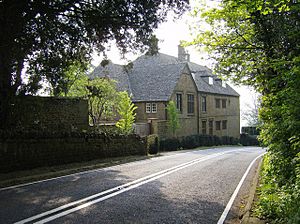Red Horse of Tysoe facts for kids
The Red Horse of Tysoe was a giant horse shape carved into a hillside in Tysoe, a village in South Warwickshire, England. It was made by cutting away the grass to show the red clay earth underneath. This special horse gave its name to the area around it, which is still called the Vale of Red Horse or Red Horse Vale.
People first wrote about the Red Horse in 1607. The very first horse shape was almost 100 yards (about 91 meters) long! No one knows exactly when it was first made. Some think it was created long ago, during the Anglo-Saxon period, while others believe it was made in the 1400s. Over hundreds of years, the horse was recut many times. It changed its shape and even its location. There were at least five different horse figures in the Vale over time. The last Red Horse was covered up and disappeared around 1910 or 1914.
Contents
Discovering the Red Horse of Tysoe
The first clear mention of the Red Horse of Tysoe appeared in a book called Britannia in 1607. The author, William Camden, wrote that a large part of the Vale was named after the horse. He said it was "cut out in a red hill by the country people."
Another writer, Michael Drayton, mentioned the Red Horse in 1612. Later, a historian named William Dugdale gave a more detailed description in his book Antiquities of Warwickshire Illustrated (1656). He explained that the horse shape was "cut upon the side of Edgehill." He noted that the earth's "ruddy colour" (red color) made it look like a Red Horse. This horse gave its name to the "fruitful and pleasant country thereabouts."
Dugdale also wrote that a local landowner kept the horse shape clear. This person held their land by promising to clean the trenches of the horse every year. Dugdale said the horse was "opposite the east window of Tysoe church."
The Great Horse and the Foal
Historians believe this first horse, which they called the "Great Horse," did not last much longer than the 1650s. Later studies of the soil showed another, smaller horse nearby. This second horse was called the "Foal." It might have been the horse that Celia Fiennes saw around 1680. She wrote about "a red horse cut on some of the hills." Some people think the "Great Horse" and the "Foal" were a group, like a mother horse and her baby.
Later Red Horse Figures
A third, much smaller horse figure appeared in the 1700s. This one faced south, the opposite direction of the earlier horses. People at the time talked a lot about this horse. One idea was that the horse was cleaned every year on Palm Sunday. This was said to remember Richard Neville, 16th Earl of Warwick's part in the Battle of Towton.
In 1772, a man named Richard Gough measured this third horse carefully. He said it was 34 feet (about 10 meters) from its back to its chest. Its shoulder to the ground was 16 feet (about 5 meters). It was much smaller than the very first "colossal" (huge) horse.
The Disappearance and New Horses
This third Red Horse was eventually destroyed. A landlord named Mr. Simon Nicholls, who ran the Sun Rising inn nearby, had it ploughed up. This happened around the time of the enclosures, when common lands were fenced off.
However, Mr. Nicholls found that his business suffered. The annual fair, which was linked to the cleaning of the Red Horse, stopped. So, he decided to have a fourth horse cut. This one was even smaller and was made near Sunrising Covert around the early 1800s.
This "Nicholls' Horse" was not considered as old or important as the others. It had disappeared by 1910. There might have been a fifth Red Horse cut on Spring Hill, a bit further away from the original spot. This last version also vanished shortly after 1914. Some older people interviewed in the 1960s said they remembered seeing it.
Finding Clues: Archaeology
In the 1960s, local historians K. A. Carrdus and G. W. Miller looked for proof of the older horses. They used old photographs, studied history books, walked the land, and used special equipment to check the soil. They published some of their findings in a book called The Red Horse of Tysoe in 1965.
They found the place where the first and largest Red Horse was located. This spot was on a hillside called "the Hangings." Old maps called it "Red Horse Hill." Using pictures taken from airplanes, they confirmed that the original horse was a galloping figure. It was about 285 feet (87 meters) long and 95 feet (29 meters) high. In 1968, more digging confirmed the shape of the horse. They also found the red clay that had been used to fill its outline.
The area where the Red Horse was located was planted with trees in the late 1960s.


